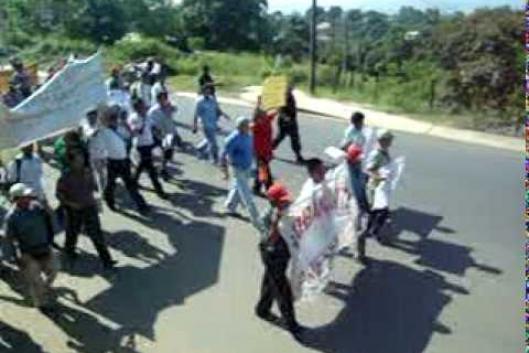In tragic circumstances such as those being suffered by the Haitian people, it becomes very difficult to think and talk about anything else. But thinking –before talking- is something that is strikingly absent in the daily information we receive about the crisis in this country.
The entire world is being bombarded with “news” fed by an army of journalists competing among each other as to who disseminates the “best” horror article or video or audio about the suffering of countless people.
Issue 150 – January 2010
OUR VIEWPOINT
COMMUNITIES AND FORESTS
-
30 January 2010The Chittagong Hill Tracts (CHT) in southeastern Bangladesh bordering Burma is one of the last remaining forested regions in the country, and is the ancestral domain of a dozen indigenous communities collectively known as the Jumma peoples (from “jum” = shifting cultivation). These peoples have ethnic, linguistic and religious identities totally different from the Bengali Muslim majority. Under British rule, the region was autonomous, largely off-limits to outsiders and almost exclusively inhabited by indigenous peoples. This special status gradually eroded after inclusion in East Pakistan in 1947.
-
30 January 2010The Copenhagen Accord - the agreement reached by a group of countries at the Copenhagen Climate Change Summit and imposed on the rest - was defined by Transnational Institute’s Praful Bidwai as “a travesty of what the world needs to avert climate change”: The two degrees Celsius increase target in global temperature is 0.5 degrees above the target accepted by the majority of UN nations; poor countries are mainly left to fend for themselves in terms of adapting to climate change; and eventually, violations of the Copenhagen Accord would have no meaningful consequences.
-
30 January 2010The Penan have been living in the rainforests of Sarawak since time immemorial. They used to hunt and gather food from the rainforest and they lived on sago, a starch extracted from the pith of sago palm stems, until the 1950s, when they decided to settle at village locations where they live today. (1)
-
30 January 2010The Naso people, also known as the Teribe or Tjer-di, live in the Bocas del Toro province in northeast Panama, in a territory spanning 1,300 km2 and covering most of the river Teribe and river San San basin. This indigenous group, which historically defended itself from colonizers and was already established in this territory when the first Spanish conquistadores arrived in the region, continue practicing subsistence agriculture and fisheries in close relationship with the surrounding nature which provides them with food, shelter, health, occupation and leisure.
-
30 January 2010The forest is not for sale! The forest must be defended! This is the clamour in the district of Barranquita, Province of Lamas in the San Martin region. The property rights acquired by the inhabitants of the hamlets in the Caynarachi river basin, located in the Peruvian Amazon, over the land they work have been violated. These people have been real guardians of the forest, looking after -on their own plots- its immense wealth in flora, fauna and water resources.
COMMUNITIES AND TREE MONOCULTURES
-
30 January 2010As experts like geographer Carlos Walter Porto-Gonçalves have repeatedly stressed, economic models based on monoculture plantation activities will always be incompatible with a healthy, balanced environment. Any industrial-scale monoculture activity, and especially plantations of millions of cloned eucalyptus trees, cannot contribute to the goal of so-called sustainable development.
-
30 January 2010There are two realities in the forestry sector in Indonesia. In one, the forests continue to be destroyed, peatswamps are drained, forests are logged, burned and replaced by industrial tree plantations. Indigenous Peoples' and local communities' rights are bulldozed along with the forests. Meanwhile, in the other reality, trees are planted, forests are restored and greenhouse gas emissions will soon become a thing of the past.
-
30 January 2010Pine and eucalyptus planting companies are advancing on land belonging to peasant family communities in several provinces in northern Mozambique. This is a relatively recent process, encouraged by the Mozambique Government that sees monoculture tree plantations as a tool to promote development and progress in the more remote regions such as the province of Niassa.
-
30 January 2010Natural forests aren’t the only landscapes being taken over by timber plantations. South Africa’s biologically diverse native grasslands are being rapidly replaced by water-intensive monocultures including eucalyptus and tropical pine – trees used for paper pulp exports. We’re standing at God’s Window, a popular lookout point just at the edge of the Drakensberg escarpment in northeastern South Africa. Below us, a 700-meter cliff plunges into a dark sea of foliage. Mile upon mile of forest fans out ahead, stretching all the way to Kruger National Park on the border with Mozambique.
-
30 January 2010Everywhere in the world where large-scale monoculture tree plantations are established, their arrival is preceded by a series of promises used to trick the local population into welcoming these ventures. After a few years have gone by, people start to realize that these promises are not being kept, and that things are actually even worse than before. But by then it is too late. The companies have taken over the area and set up their plantations.
-
30 January 2010The term “planted forests” was coined by FAO with the aim of placing tree plantations on the same level as forests. Gradually it has spread and been assimilated by many international and national organizations, while multinational corporations from the forestry sector have taken advantage of this to emphasize the matching, as was evident at the latest World Forestry Congress, held in Argentina in October 2009.

